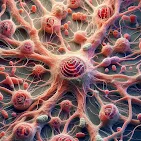Methamphetamine (METH) is a highly addictive stimulant that wreaks havoc on the brain and behavior. This highly prevalent drug not only creates intense cravings but also leads to a significant decline in cognitive function over time. With current treatments focusing on managing addiction itself, a new approach targeting the cognitive damage caused by METH offers a glimmer of hope.
METH's Deleterious Impact on the Brain
Chronic METH use disrupts the brain's reward system, specifically areas like the Ventral Tegmental Area (VTA) and Nucleus Accumbens (NAc). This disruption leads to intense cravings and compulsive drug-seeking behavior, making it incredibly difficult to quit. Additionally, METH significantly impairs cognitive abilities, impacting memory, learning, and decision-making. This decline in cognitive function poses a major challenge for individuals struggling with METH addiction.
Treatment Challenges and a Promising New Direction
Currently, there's no single magic bullet for METH use disorder. However, research suggests that addressing cognitive deficits could be a valuable complementary approach. Studies using Memantine, Berberine, and Melatonin in animal models have shown promise in improving cognitive function after METH exposure.
Paeoniflorin (PF): A Natural Light on the Horizon
Paeoniflorin (PF) is a natural compound extracted from the Paeonia lactiflora plant. This compound boasts a range of therapeutic properties, including anti-inflammatory, antioxidant, and neuroprotective effects. These properties have made PF a potential candidate for treating neurodegenerative diseases like Alzheimer's and Parkinson's. Notably, studies show PF's success in reducing cognitive decline and inflammation in animal models of these diseases. Furthermore, PF seems to improve spatial learning and memory function, crucial aspects of overall cognitive well-being.
A New Study Tackles METH-Induced Cognitive Decline
A groundbreaking new study is investigating the potential of PF to counteract the cognitive impairment caused by METH in mice. This study utilizes various tests, including new location recognition (NLR), new object recognition (NOR), and Y-maze tasks, to assess the cognitive function of mice treated with both PF and METH. Additionally, the study examines how PF might influence reward-seeking behavior induced by METH.
To delve deeper into the potential mechanisms of PF, researchers will analyze changes within brain regions like the VTA, NAc, and Hippocampus. These regions are crucial for memory and synaptic function, and the study will investigate changes in protein levels associated with these functions (PSD-95 and synaptophysin) to understand how PF might be working.
Overall, this exploration of PF as a potential treatment for the cognitive deficits linked to METH use disorder is a compelling development. By investigating both the cognitive and behavioral effects of PF, this study offers valuable insights into a promising new therapeutic avenue for individuals struggling with the long-term consequences of METH addiction.
Reducing Cravings and Protecting the Brain
The research showed that PF successfully reduced two key aspects of METH addiction in mice (Gong et al, 2024):
- Expression and reinstatement of conditioned place preference (CPP): CPP is a behavioral test used to measure an animal's association of a place with a rewarding experience. The study suggests PF helps prevent the development of cravings associated with METH use.
- Synaptic protein levels: METH can increase levels of specific proteins linked to addiction in the brain. PF appears to counteract this effect, potentially protecting brain cells from damage caused by METH.
What This Means
This research is a significant step forward. While the study was conducted on mice, it lays the groundwork for further investigation into PF's potential as a treatment for METH addiction in humans.
Important Note:
It's crucial to remember that this is preliminary research. More studies are needed to confirm these findings and determine PF's safety and efficacy in humans.
The Future of Addiction Treatment
This research offers a promising lead in the fight against METH addiction. PF's potential to reduce cravings and protect brain cells is a significant development. As research progresses, we may see PF emerge as a valuable tool for helping people overcome METH addiction and reclaim their lives.
References
- Gong, Xinshuang & Yang, Xiangdong & Yu, Zhaoying & Lin, Shujun & Zou, Zhiting & Qian, Liyin & Ruan, Yuer & Si, Zizhen & Zhou, Yi & Li, Yu. (2024). The effect of paeoniflorin on the rewarding effect of METH and the associated cognitive impairment in mice. 10.21203/rs.3.rs-4430457/v1.



























